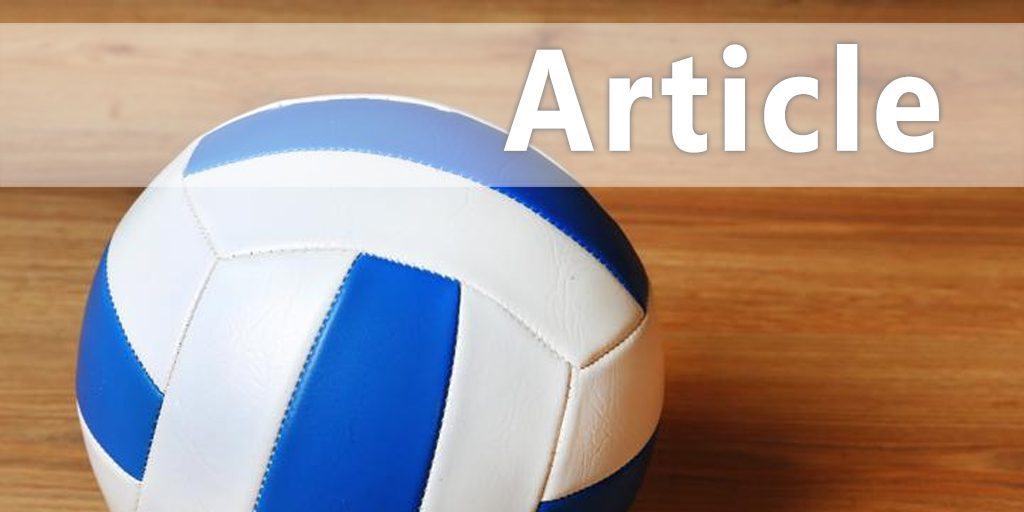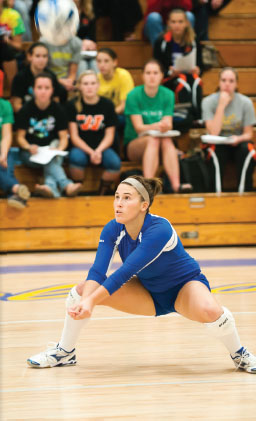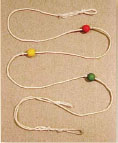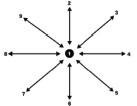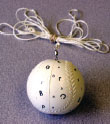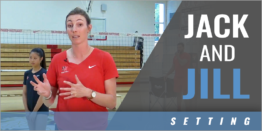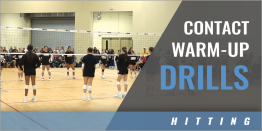|
By: Sue Sinclair (Retired) - Previously the Head Women's Volleyball Coach at Illinois Central College. Originally Published in: Coaching Volleyball Magazine Provided By: AVCA
The great volleyball players make the game look easy because they have vision. They can read both the opponents and their teammates, with a solid understanding of eye sequencing and peripheral awareness to be ahead of the play. Indeed, we can't train a 5'8" player to be 6', but we can train the 5'8" player to see what the 6' player is going to do — and react to it immediately. Seeing is knowing and knowing is the beginning of execution. Why use Sports Vision Training? The obvious reason for incorporating sports vision training into a volleyball practice is the visual system leads the motor system. When an athlete improves his/her visual skills, overall performance is greatly enhanced. An athlete's focus and concentration are also greatly improved, getting the athletes in the zone. According to the late Greg Giovanazzi, in his article "Seeing is Believing" (Volleyball Magazine, Vol. 6, No. 11, 1995), "When people talk about vision in volleyball, they're not just discussing what one sees but also what is recognized and then acted upon. The recognition aspect of vision is often referred to as reading. Great attackers read the block; great diggers read the attacker; great blockers read the setter; and setters read the blockers. The game, at all levels, is won and lost with vision and action based on what is seen." There are several quick and inexpensive ways to train and improve an athlete's pe-ripheral awareness, tracking and depth perception. In addition, with sports vision training, the athletes will learn the key eye sequencing for various court skills.
Balance Training An athlete's vision is directly connected to the proprioceptive center in the brain through the optic nerve fibers. According to the American Heritage® Science Dictionary (2005), "Proprioception is the unconscious perception of movement and spatial orientation arising from stimuli within the body itself. In humans, stimuli are detected by nerves within the body itself, as well as by the semicircular canals of the inner ear." These centers control the awareness of the body in space. A perfect example of proprioception is to balance on one leg with your eyes closed versus open. Dynamic sports vision training involves balance training, both generic and sport-specific. Sports Vision Training Exercises The book SportsVision: Training for Better Performance by Thomas A. Wilson and Jeff Falkel, provides 50 sports vision training exercises and activities. At Illinois Central College, we have culled our favorites in relationship to volleyball training and engage in the vision exercises at least twice a week at the beginning of practice for approximately 10 minutes. During the session, two athletes are positioned at each station and then all athletes rotate through 10 stations. Most of the exercises are one minute in length, while some are as short as 30 seconds. Exercises 1) Brock String or Eye Beads:
The Brock String, named after Frederick Brock, OD (1899-1971), works on eye teaming and depth perception. Basically, it is a white string of approximately 10 feet in length with three colored beads attached. In this drill, the athletes are working on ensuring their eyes team together. Since a human's central point of focus is no bigger than the thumb, this drill will strengthen the muscles in the eyes so they are working together to find the central focus point of an object. Stand and hold the string between your eyes at the tip of your nose. The other end of the string is tied to a fixed point, while the beads are spaced at various distances. Use both eyes to look at one bead. When you are looking at it, the bead is about as big as your thumbnail and will look like two strings are going into it and two are coming out (if the athlete is looking at the first bead, he/she should see two of the next). Move from one bead to the next. You can increase the difficulty of the drill by affecting the athletes' balance. In other words, make the athletes stand on one leg while doing the drill. It gives the athlete a better sense of balance and vision and how they coordinate with each other. In the minute they are at the station, 30 seconds in, blow the whistle and have the athletes switch legs. 2) Pendulum or Marsden Ball:
The pendulum or Marsden ball helps the eyes develop smooth tracking while the person is simultaneously thinking about something else.
Have two athletes lie head to head on the floor so that both of them have the ball hanging above their heads in the line of vision. Move the ball in different directions and make sure they are not moving their heads, only their eyes. A human has nine different fields of gaze and you want to train all of them. Therefore, move the direction of the swing, take different angles and move in different circles. You can make the exercise tougher by giving them math problems simultaneously. 3) Near and Far: This drill works on tracking and depth perception. The athletes stand on one leg, hold a fingertip out in from of them, focus on their fingertip, and then focus on something further away. Halfway through this exercise, have the athletes not only change which leg they are standing on, but also change posture. This makes the drill more specific to volleyball, since they are maintaining either a low, defensive posture or they are in an upright blocking/setting posture. 4) Hot Dog in the Sky: This drill is used to control eye movements and flexibility of the visual system. Have the athletes hold two fingers out in front about 1/4 of an inch away from each other. Focus on something beyond, like the wall. The athlete should see a floating "hot dog" between the two fingertips, which is an interesting illusion created by your eyes' focus. Then have the athletes switch between focuses and discover the hot dog will disappear and reappear each time. 5) Arrows Chart: Make a couple of large charts with arrows facing different ways and tape them to a wall in the gym. The athlete stands in front of the arrows chart and has to point with his/her hands and also say the direction the arrow is pointing (left, right, up, down). Utilize a metronome to determine the speed of the exercise. To make the exercise more difficult, have the athletes point in the opposite direction from the way the arrow is pointing and say the opposite direction. If the arrow is pointing left, you want them to say right and point right. You can also have the athletes jump in the direction the arrows are pointing. Finally, you can have them look at a chart on the wall, as well as an index card in their hands, and now they have to go back and forth from reading the index card to the chart on the wall. All the while, the athletes are working on depth perception, but also training processing and reaction times. 6) Random Numbers with Metronome: This exercise trains peripheral awareness. Draw numbers randomly on a chart and post it on the wall behind the athletes. They then have to turn, look over one shoulder, and point, finding the random numbers in order. While the athletes are pointing at the number 1, you hope their peripheral vision is trying to find where 2 is for the next time. Do this drill for one minute. Halfway through, blow the whistle and change which shoulder they are looking over. This way, you can ensure they are training both fields of vision. The athlete is performing the exercise to the tempo of the metronome to maintain pace. 7) Straw and Toothpick: This exercise is conducted on a balance board. One athlete holds the toothpick on the balance board and the other athlete holds the straw, parallel to the ground, about 2 feet away. Practice quickly inserting the toothpick into the straw while on the balance board. Have the athletes with the straw move it to a new location each time, trying to hit all nine fields of gaze. 8) Juggling: This exercise is literally teaching the athletes to juggle. Have the athlete take one ball or a lighter object like a scarf in his/her dominant hand and throw the object in an arc, about eye level, from hand to hand. Then add a ball by taking one in each hand. Throw the object from the right hand in an arc to the left; about halfway through the arc, have the athlete toss from the left hand over to the right. Have the athletes practice with two balls until juggling can be done smoothly. Eventually, include one more object for a total of three. With two objects in the right hand, begin by throwing one from the right to the left. Then, midway through the arc, throw the object from the left to the right. Halfway through that arc, throw the other object from the right to the left hand. The athlete is juggling! To make it easier for the athletes, put them in front of a wall and then the object will bounce off and they don't have to chase the items they drop. This teaches rhythm and timing, which are key on the volleyball court. 9) Mirror: Have the athletes face each other and "monkey see, monkey do" in movement. The key here is the athletes have to stare at each other in the eyes, which teaches them to concentrate on a central focus point while being aware of what else is happening around them. 10) Reaction Balls:
Reaction balls can be purchased through physical education magazines or you can actually use a Kong® dog toy. Begin the exercise with two partners, spaced a short distance apart. If the two are closer together, let the ball bounce only once before it is caught. To increase the difficulty, have the athletes do the exercise in a defensive posture to simulate a defensive drive and step move. Also insist that they use two hands when they react to the ball that is being tossed. Move further apart after 30 seconds and let the ball bounce twice. You can also have two balls going at once. 11) Balance Beams: Place a 4x4 piece of 1 wood in the gym. Engage in static exercises with no ball or stand on the balance beam and maintain a defensive posture. The partner who is not on the beam tosses the ball and the other has to play the ball back while on the beam. The same con-cept works with a mini trampoline. 12) Pooh Balls: These are the smaller circumference balls you find at any discount store. Have the two athletes at this station engage in several different activities with the smaller ball, including: staying in passing form and passing the ball back and forth; or partnering on the balance beam, tossing the ball and having the other pass it. 13) Tennis Balls: This exercise tests the concept of knowing where you are in space and time. Have an athlete face the wall with a partner behind, who has two tennis balls. The one with the two balls tosses them, one at a time, over the shoulder of the one facing the wall. The person facing the wall has to catch the balls as they bounce off the wall. Mix things up a bit by having the tosser say which shoulder he/she is going to toss it over and then the catcher has to catch it with the opposite hand. 14) Shoe Eyelets: Have the athletes stand and look down at their tennis shoes. For the really fine muscle movement of their eyes they must track the laces on the shoe from eyelet to the eyelet up and then back down. 15) Colored or Lettered Ball: Similar to the Pooh Ball drill, have the athletes do any activity (setting, passing, etc.) and have them call out what they see written on the ball, whether it be a colored dot or a letter or number. 16) Passing Two Balls: Two athletes are partner forearm passing. As one passes the ball in the air, the other rolls the ball on the ground, maintaining posture. Or, have one athlete set the ball while the partner chest passes it. 17) Flash Cards: Get a deck of cards and put a dot in the center of each card at the top. Have the athlete fan the cards to flip them. Flip the card over and the athlete has to stare at the dot and identify the 7 of clubs, 9 of hearts, etc. He/she has to go as fast as possible. 18) Thumbs for Peripheral Awareness: Have the athlete stand on a balance board and move the thumbs around in different places while looking straight ahead to see how far the peripheral vision goes. 19) Strobe Light: This drill can be extremeley beneficial and has been used very effectively at elite levels in baseball and tennis. It requires a dark room, however. Have the players play volleyball in a room with the strobe light going at different tempos. This drill also teaches the concept of framing, which means you don’t see the spin on the ball any more. For example, you might see the word Tachikara, the plug or separate panels instead. When you play with a strobe light, it looks like a stopped object in mid-air. Conclusion: One of the best ways to improve your players’ volleyball IQ is with sports vision training. Usually, inexperienced players watch the ball and that is it. There is so much more visual information they need to pay attention to. As a coach, you need to focus on what the players are looking at, as well, helping them to process the information they are bringing in so they can act on it quickly. Constant eye movement, reading through the net and effective use of peripheral awareness will help make the good volleyball player great.
|
